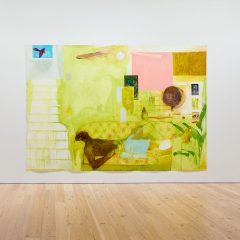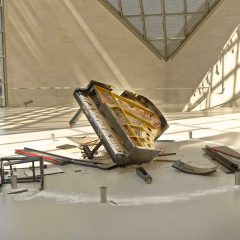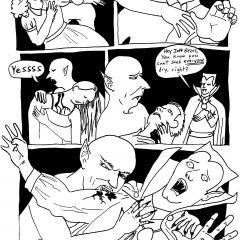[Our U.K. correspondent Katie brings us a review of a thought-provoking show that at first glance might seem cheerful and colorful, but which addresses complicated topics without casting final judgment. — the Artblog editors]
Pascale Martine Tayou’s first solo London show, Boomerang, is utterly compelling: a global-minded and generous show that takes on some of humanity’s biggest difficulties, both among ourselves, and in our relationship with nature and the environment. The self-taught artist has filled Serpentine Sackler Gallery to its brim with strong colours, visceral textures, and broad-visioned comments on our international community.
Born in Cameroon, Tayou works between Yaoundé, Cameroon and Ghent, Belgium, taking part in a catalogue of international exhibitions. Talking about the title of the show in a video interview on the Serpentine’s website, he says, “Boomerang is something [that goes] and comes back. I had to define […] what it means to be a human being.” This certainly seems to be true of his own life, and living as he does, bridging such different worlds, is perhaps what gives this show its broad-viewed insights.
Soft to touch, but hard to face
The Sackler gallery’s rooms are filled with references to different cultures, colonialism, international trade, and natural resources. Among the diverse sculptures filling every corner and the oil pipes running the length of every wall are scrawled accounts of the devastating effects of pollution and mineral exploitation on communities in Indonesia, Zambia, Nigeria, and so on. The writing is simply phrased, its handwritten directness keeping this justified admonition from becoming a lecture.
The ceilings of both long galleries are filled with black branches with plastic bags in jewel-like colours caught in their twigs, hanging illuminated by the skylights; these are echoed by chunks of coloured glass that hang in gemstone-shaped cages from the ceiling, a reference to the natural resources pillaged from colonised Africa. These appear again in a hanging installation in one of the centre galleries entitled “Our Traditions”: a frame filled with gourds, handmade brushes, and traditional African masks that are this time rendered as blown-glass globes. Such objects, to the European eye, fit the stereotypical view of African art, but here they are always presented with an edge, mingling with the “contemporary objects taken from the modern fetishism” that Tayou describes in Le Grand Sorcier de Utopie.
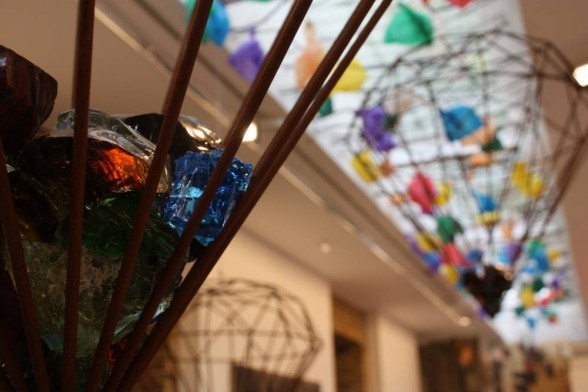
In the next room, a gorgeous cotton cloud hangs glowing from the ceiling, punctured by sharp wooden shafts. The title is “Coton-Tige,” the French name for a Q-tip, which literally means “cotton stick”. In the Serpentine interview, Tayou talks about “what happened between people from different continents, different education, different parts of the world,” in the cotton trade. Cotton itself is soft, beautiful, and yet the lives of people working on cotton farms were hard and full of pain. “For me, it’s how to link this past with the present,” he explains. “I’m talking about slavery, of course. About what it means to be a slave. This duality is very important for me…This harmony is the sense of life. Sweet and bitter and sharp and soft.”
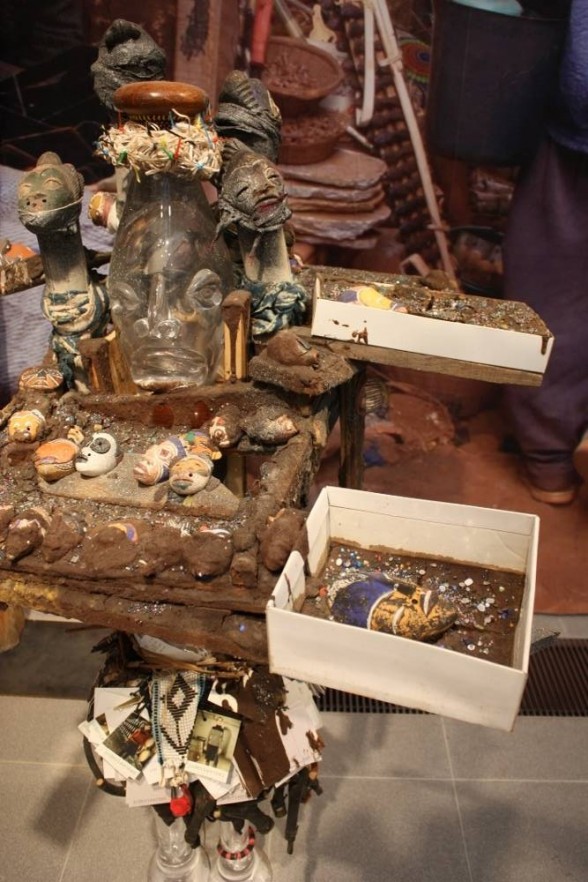
What’s remarkable in the way that Tayou speaks, and in the atmosphere of the whole show, is that he confronts difficult, painful topics head-on but his response is always multifaceted, open. His “Sauveteur (Vendeur de Passeports)” (translated: Lifeguard (Passport Seller)) is a figure blown in glass and adorned with mud, beads, talismans, and plastic hair held with colourful ties, its belt draped in clothing tags for a Belgian fashion designer. It has the look of a fetish doll, which is given power by accumulated objects; passports are given power by an accumulated consensus among a large group of people. Ideas of trade, commerce, and the accepted currency of official documents are embodied in this figure, yet the conversation remains open; no judgement is reached.
Simple, powerful, and colorful
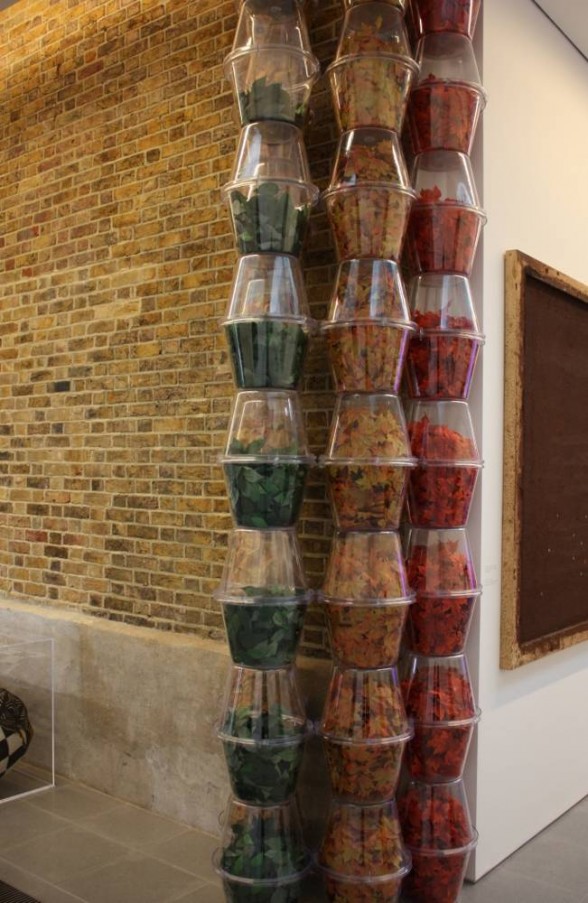
Tayou’s installations make remarkable use of the gallery layout–it seems that no feature of the space is without its creative use. Each of the two central rooms houses its own perfectly-fitted installation; the busy layout in the surrounding gallery space is pleasingly semi-symmetrical; the back wall is papered with huge photographic blow-ups. At two different corners of the gallery, there are floor-to-ceiling towers made from buckets and basins whose stacked forms echo Brancusi’s “Endless Column,” one in colourful cooking implements, the other clear plastic buckets filled with fake leaves. The latter is titled “The Last Tree,” a reminder that some great columns, however commonplace they may seem, are by no means endless.
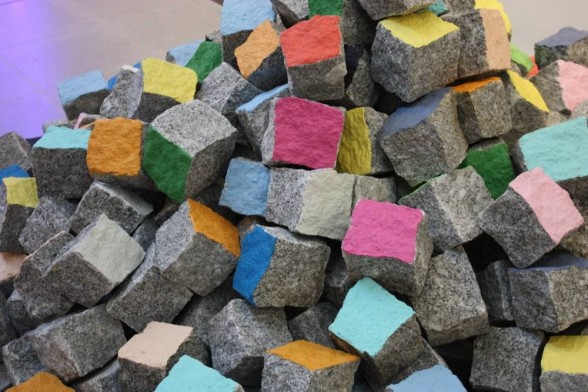
For its striking simplicity, the work that I could not forget was “Pavés Colorés,” a pile of paving blocks, each with one side brightly painted. Usually, we see only one side of these blocks on the streets of our cities, but here their physicality is brought out by the bright hues and occasional accidental smudges of paint, traces of the hands that coloured them. It’s a reminder that these blocks underfoot were at some point hewn from rock, by a particular person, in a particular place. Tayou describes these painted blocks as a kind of self-portrait. “I am a ‘coloured’ guy,” he says. “Black people as ‘coloured’. As coloured as like a stone rolling; I could be dangerous, there could be revolution. Many coloured people could be blue, red, yellow, maybe white! We are all coloured stone.”
Boomerang is open until May 17, 2015, at the Serpentine Sackler Gallery, Hyde Park, London.


